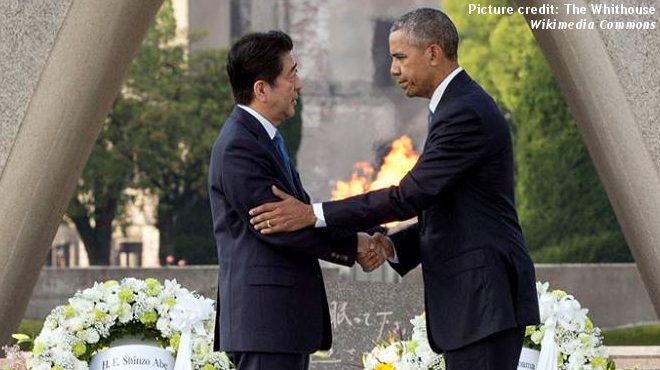Abe’s Visit – reconciling with the past

Steps in the right direction
When President Obama became the first American president to visit Hiroshima in May this year, some thought that the gesture should be reciprocated. Now, this has materialized with Japanese Prime Minister Abe Shinzô stating that he will visit Pearl Harbor together with Obama on December 27.
Although it has been communicated that this will be the first time a Japanese Prime Minister will travel to Pearl Harbor, there are reports that Prime Minister Yoshida Shigeru attended the site in 1951 during a stopover in Hawaii after having signed the peace treaty. Regardless of whether or not Abe is the first (or second) prime minister to attend the site, the symbolic value of his visit is most certainly the real story here.
Symbolic gestures such as visits have broad effects. For one, they act as strong counter-points which (hopefully) make it more difficult for revisionist historians to argue that the postwar period is not over. Second, visits like these cement security arrangements in the region. Third, and most importantly, they signal from both parties that steps are being made towards reconciliation. In practice, the United States and Japan have already developed ties that go way beyond the hostile relations of the past. They are now allies in military terms and work closely together on diplomatic issues as well as collaborate in areas such as science and technology.
Reconciling Sino-Japanese relations
Looking more broadly towards the region, if symbolic acts like these can bring the U.S. and Japan closer to recognizing past history, similar gestures could form a decent starting point for reconciling Sino-Japanese relations.
As has been officially acknowledged by Japanese Prime Ministers, Foreign Ministers, Speakers and, not least, Emperors, Japan caused enormous suffering in neighboring countries during the first half of the last century, not least in China. It was with a great amount of courage that the Chinese leader Deng Xiaoping, in connection with the signing of the 1978 Treaty of Peace and Friendship between China and Japan, declared that the two countries should, “let bygones be bygones”. This was not intended to be interpreted as China having declared that past actions should be forgotten or that they were not of importance, but rather that they should not stand in the way of a constructive bilateral relationship.
Indeed, since then the relationship between Japan and China has been reinforced. First, the economic cooperation between the two countries has taken off at an impressive scale. Currently, China is Japan’s second-largest export destination and Japan’s top supplier of imports whilst Japan is China’s third-largest export destination. Japanese investments and loans contributed to the rapid rise of China and the Chinese market has become of vital importance for the Japanese economy. Last year for example, China received 8.8 percent of total Japanese foreign direct investment (FDI).
A second and more recent factor that has strengthened Sino-Japanese relations can be seen in the light of their “four-point” consensus. This consensus was agreed to in 2014 in order to reduce tensions over the Senkaku/Diaoyu islands. The first point was a pledge to “continue to develop a mutually beneficial relationship based on common strategic interests”. The second point was that both sides should face, “history squarely” and “look forward to the future”. As for the Senkaku/Diaoyu territorial controversy, the two sides acknowledged, as a third point, “that different positions exist”. Fourth, China and Japan agreed to “gradually resume political, diplomatic and security dialogue through various multilateral and bilateral channels”.
Whilst these factors certainly move their relationship forward, what is still missing from this relationship are the kinds of broad symbolic efforts like those recently made by the U.S. and Japan. Moreover, (as point two in the consensus indicates) there are still gaps in the way each State views their history. Indeed, Abe’s attendance at Pearl Harbor is still highly controversial to some members within his party. For revisionism not to infect a continued healthy bilateral relationship between China and Japan there is considerable work that should be done towards reconciling. Therefore, in the same way that Obama’s visit led to a reciprocal visit from Abe, one would hope to see a correlative arrangement between Japan and China. Recent statements by Chinese government officials indicate they would at least welcome such a visit.
More than 70 years have passed since the end of World War II, but without efforts to reach reconciliation in the form of symbolic gestures, history risks living on in a destructive form. Reconciliation is not the same as forgetting. On the contrary, it is a recognition that the pain and the scars of the past are there, that they still exist, but also an action that declares that they will serve as a lesson for the future.
Dr. Lars Vargö is former Swedish Ambassador to Japan (2011-14) and South Korea (2006-11). He holds a Ph.D. in Japanese studies (history) from the University of Stockholm (1982). In 1972-76 he was a repeat Mombusho scholar at Kyoto University. As a diplomat Vargö has returned to Japan four times, but has also served in Libya, Lithuania and the United States. 2001-2005 he served as Ambassador and Head of the International Department of the Swedish Parliament.
Ms. Rebecka Nygren began her internship at ISDP in August 2016. She is a 4th year student at the Law School at Uppsala University, Sweden. At ISDP, Ms. Nygren will be affiliated with the Stockholm Japan Center, and will conduct research on Swedish-Japanese relations, as well as on gender issues in Japan.